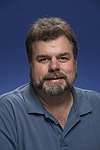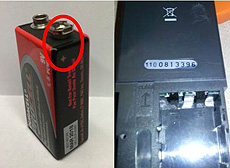Check the polarities on your batteries
 |
|
David Mertz
|
David Mertz, electrical safety engineer, wrote this column.
Recently, a PPD employee discovered a 9-volt battery (see picture below) whose terminal polarities were improperly marked. For this type of battery, the smaller of the two posts is the positive terminal. But as you can see in the picture, the larger terminal is marked as the positive one. The employee reported that the battery was obtained from the Fermilab stockroom and had a unique production code marked on the bottom.
These batteries present an equipment damage risk, as many devices are not designed to protect against reverse polarity. In this instance, the employee inserted the battery into a Techma clamp-on current meter that was equipped with spring clips. He followed the printed mark on the battery, which resulted in inserting the battery backwards. The meter was not constructed to prohibit a battery from being inserted incorrectly. As a result, the meter was damaged.
The employee reported this to the ESH&Q Section, and the issue is being investigated. The Fermilab stockroom has verified that no improperly marked batteries remain in stock.
In the meantime, Assistant Director for ESH&Q Martha Michels advises that, prior to inserting a battery in an instrument that allows the battery to be inserted in either direction, ensure the positive (smaller terminal) is aligned with the positive terminal on the instrument. Please inspect any 9-volt batteries you use to ensure they are marked properly.
If you find improperly labeled batteries, please inform your senior safety officer and return the batteries to the stockroom. Any equipment damaged by these improperly marked batteries should be documented and reported to J.B. Dawson in the ESH&Q Quality Assurance Group.
 |
Left: The battery's terminal posts are mismarked. Right: The back of this electrical current clamp allows the battery to be inserted in either direction, allowing batteries to be installed incorrectly. Photos: Curtis Danner, PPD
|
|